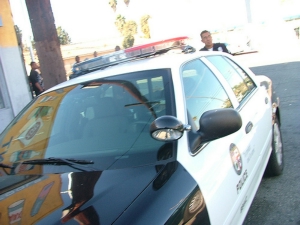
Nationwide in 2010 as of last week: 70 officers have
died in crashes, 54 by gunfire |
|
Car crashes, not gunshots, biggest threat to officers
Nationwide in 2010 as of last week: 70 officers have died in crashes, 54 by gunfire
by Michael Dresser
The Baltimore Sun
December 5, 2010
When we think about police dying in the line of duty, we tend to flash to a thought of a criminal maliciously gunning down an officer.
But a more common fate for law enforcement officers is to be killed in a vehicle collision. |
According to the National Law Enforcement Officers Memorial Fund, as of last week there had been 70 officers killed nationwide in vehicle incidents compared with 54 killed by gunfire in 2010. Crash fatalities among officers were up 49 percent over the same period in 2009. The majority are killed in crashes involving a single moving vehicle.
The Baltimore Police Department has lost two of its own to such crashes in recent months. In September, Officer James E. Fowler III died when his Chevy truck went off a road in central Pennsylvania while on his way to a police training course at Penn State University. Less than a month later, Officer Thomas Portz Jr. was killed when his patrol car ran into a fire engine parked on U.S. 40 while responding to a call.
There is no denying these officers' service. Nor is there any doubt about the tragedy of their deaths. But now that the funerals are over, it would be a mistake to brush aside the disturbing questions raised by these crashes. Not about two individuals but about the police department's training and culture when it comes to operating motor vehicles.
In neither case is there anything to indicate anyone other than the driver was at fault.
Fowler drove off U.S. 22 near Lewistown, Pa., Sept. 27 and hit a berm. Baltimore police spokesman Anthony Guglielmi said the crash was "weather-related."
Portz was answering a call about an injured person in the street when his patrol car hit the fire truck at a speed Guglielmi estimated at 70 mph. He was killed and four firefighters were injured.
In the days immediately after such losses, nobody wants to dwell too much on the errors that led to needless deaths. But at some point, the city and the department should take a hard look at how its officers drive — and give an accounting to the mayor, the City Council and the public.
In Fowler's case, blaming the weather avoids hard facts. It was early fall. There was no ice or snow on the highway. We're talking about rain. Every driver, police officer or not, is expected to drive at an appropriate speed and muster the required concentration to keep a vehicle on the road even in miserable conditions.
The Oct. 20 Portz case is even more disturbing — and not just because no injured person was found. It raises serious questions about how the department trains its officers to respond to emergencies and how it reacts to fatalities when they do happen.
Guglielmi gave the standard defense of the officer's apparent decision to rush to the scene at high speed. "If it's your daughter or your mother having a heart attack, you want the police there in two seconds," he said.
If you weigh the risks of an officer driving to the scene at 50 mph versus racing there at 70 mph for a report of an injury, I don't see how you don't come down on the side of the slower speed. Driving at high speeds puts the officer, the public and — as it turned out — other first responders at risk. A delay of two or three minutes in an officer's arrival would seem to be a minimal risk to the injured person.
The spokesman declined to second-guess the decision to drive to the scene at that speed and speculated that Portz might have been distracted.
"We don't know if he sneezed. We don't know what happened," Guglielmi said. Crashing under those conditions, he said, doesn't represent a flaw in training.
With all due respect, it would. Drivers are expected to retain control in the face of distraction — even a sneeze.
The fact that an officer would feel compelled to drive so fast to a fairly routine call makes me wonder what messages were absorbed at the police academy and in the department itself. Don't police realize their driving is scaring people?
Guglielmi said the city has determined that so far this year there have been 224 police-involved crashes in Baltimore that the officer could have prevented. He said that's not bad considering the police log up to 1.2 million miles a year. Maybe, but a better message to come out of the commissioner's office would be that it's 224 too many.
On PoliceOne.com, Capt. Travis Yates of the Tulsa , Okla., Police Department, a national expert on police driving, was unsparing of his profession in an article called "How We Die — the Untold Story."
"I fear that we have somehow minimized these collisions by calling them 'accidents' and throwing our hands in the air as if we can't do anything. Whatever we're doing, it's not working," he wrote. "I do not shy away from placing blame square on the shoulders of police chiefs and sheriffs for the failure to train their officers."
When I asked Guglielmi about whether Commissioner Frederick H. Bealefeld had taken any particular initiatives in the field of police driving safety, he couldn't think of any.
Perhaps it's time the commissioner took some steps to send a strong message through the ranks — as Commissioner Thomas C. Frazier did in the 1990s.
When it comes to driving, the officers who best protect the public are the ones who protect themselves.
|